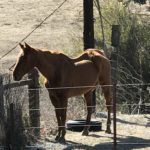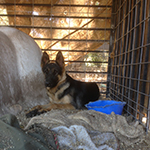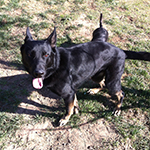|
|
$5,500 Reward Offered for Information Leading to Arrest and Conviction of Coyote Pup Torturer
Posted on August 6, 2014
For immediate release:
Contact:
Lisa Franzetta, ALDF
Megan Backus, ALDF
SANTA MARIA, Calif. — The national nonprofit Animal Legal Defense Fund (ALDF) is offering a $2,500 reward for any information leading to the arrest and conviction of the perpetrator(s) who tied and tortured a six pound female coyote pup in Santa Maria, Calif. According to media reports, the pup was spotted last Thursday, July 31st by a plumber who saw her tied to a post in an alley. Starving and severely dehydrated, her jaw was also broken and she had puncture wounds on her neck. Electrical cord was wrapped tightly around her neck and arms—the puncture wounds match the ends of the cable pieces and preliminary investigations suggest the animal may have been tortured.

A good Samaritan brought the coyote pup to Animal Control in Santa Maria, and that’s where local rescuers stepped in to help. Julie Di Sieno, of Animal Rescue Team Inc. rushed the pup, who was barely breathing, to the Solvang Veterinary Hospital, where Dr. Macveigh initiated life-saving efforts and removing the maggots from the coyote’s rotting wounds.
Under California Penal Code § 597(a), anyone who “maliciously and intentionally maims, mutilates, tortures, or wounds a living animal” can face misdemeanor charges—one year in county lockup and/or a $20,000 fine—or felony charges amounting to up to three years in county jail and/or a $20,000 fine.
The Animal Rescue Team is offering a $3,000 reward, for a total of $5,500 with the Animal Legal Defense Fund’s reward offer. Funds are sought to pay for the coyote’s surgery.
“Although we are relieved such good care is being given to ease the tremendous suffering of this coyote pup, there is a dangerous animal abuser on the streets who needs to be brought to justice,” says Stephen Wells, ALDF executive director. “We call on anyone with knowledge of this horrific act to come forward for the safety of other animals and the people of this community.”
If you have information relating to the identity of the person or persons who mutilated this coyote, please contact the Animal Legal Defense Fund at 707-795-2533, x 1010.
HARD TO BELIEVE: This 6LB female Coyote puppy was found tied up with stereo electrical wire/cord. She was discovered On Thursday July 30 at 5PM. When rescued she was suffering from starvation, severe dehydration, an awful wound from the choke hold on her neck, as well as a badly broken lower jaw. Julia rushed her to Solvang Vet Hospital. Dr. Macveigh immediately began life saving efforts, and removed all the maggots. She is now resting at our facility, eating a soft food diet, and drinking on her own. We also removed her IV line today. We HOPE this case is prosecuted to the fullest extent of the law if abuse can be proved.
We need donations so we can continue our work in the Santa Barbara County.
Thank you,
ART, Inc
Not only was today the longest day of the year, it was also another busy one for
Animal Rescue Team, Inc.
We rescued 7 different native/none native baby birds today. We would like to remind
readers NEVER trim tree's during spring or early summer. Many bird nests are
destroyed during tree trimmings leaving behind many orphans such as these two. The
starling, and swallow are some of today's lucky ones, receiving around the clock
care at our wildlife rehab facility located in Solvang.
For those who would like to help, please visit our website wish list, under our
donation tab.
Enjoy,
ART, Inc.
Volunteer!
Click HERE to download our Brochure.
We are also an official County of Santa Barbara Juvenile probation, community service work site.
Become a Member of Animal Rescue Team
Pledge your support of animals in need when you join as an Animal Rescue Team member. Membership directly support animals in need. To join our team please click here.
Clarice, a four day old baby lamb rescued by the Animal Rescue Team Inc. in Solvang, California. After a traumatic start to her life, little Clarice was nursed back to health and is on now her feet and ready to explore.
To find out how you can help the Animal Rescue Team care for Clarice and the other animals in their care, visit animalrescueteam.net or on Facebook: facebook.com/122334mommy
Cancellation Process for 12 D-Con Mouse and Rat Poison Products
News
Rodenticides SAP Meeting
Resources
Current as of March 2013
EPA is initiating regulatory action to cancel and remove from the consumer market 12 D-Con brand mouse and rat poison bait products. The manufacturer of these products has refused to voluntarily adopt risk mitigation measures that are necessary to protect children, pets, and wildlife.
On This Page
Notice of Intent to Cancel (NOIC)
EPA is moving forward and initiating action under the Federal Insecticide, Fungicide, and Rodenticide Act (FIFRA) to cancel and remove from the consumer market 12 D-Con brand mouse and rat poison products. These products fail to comply with safety measures that EPA asked registrants to adopt by June 2011 and that are necessary to protect children, pets and wildlife from accidental exposure to rodent baits used in and around the home.
The 12 D-Con mouse and rat poison products are produced by Reckitt Benckiser, Inc. and sold to general consumers as pellets or powder without adequately protective bait stations that prevent access by children and pets. Eight of the 12 products also contain one of four second generation anticoagulants, rodenticide active ingredients that EPA has determined pose unacceptable hazards to non-target wildlife and should not be allowed for use by consumers. EPA has found that the 12 D-Con products cause unreasonable risks to children’s health and the environment. New rodent control products that meet the agency’s safety criteria are now widely available, effective and affordable, and pose significantly less risk to people and the environment.
Cancellation Hearing
EPA will hold an administrative hearing to cancel the registrations of 12 D-Con mouse and rat poison products that fail to comply with the agency’s safety measures. The registrant Reckitt Benckiser has requested a hearing in response to EPA’s February 5, 2013, Notice of Intent to Cancel. Until the hearing before an EPA Administrative Law Judge is completed, the company may continue to market the 12 non-complying products.
EPA encourages residential consumers to use only mouse and rat products that meet EPA’s safety standards.
For more information on the involuntary cancellation process, see Pesticide Cancellation Under EPA’s Own Initiative.
Top of page
SAP, USDA and HHS Review of EPA’s Proposed Cancellation
As part of the administrative cancellation process in FIFRA section 6(b), EPA convened the Scientific Advisory Panel on November 29 through December 1, 2011, to obtain independent review of the scientific basis for the proposed cancellation of 20 rodenticide products. The agency provided a draft Notice of Intent to Cancel and the documents supporting it to the SAP in advance of the public meeting. EPA received the SAP’s comments and meeting minutes in late December 2011 and early January 2012. These documents are available in docket EPA-HQ-OPP-2011-0718 at www.regulations.gov.
EPA thoroughly reviewed and considered the input from the SAP before issuing our final decision to cancel. The agency’s response to the SAP’s input, including additional analysis conducted at the suggestion of the SAP, is available in docket EPA-HQ-OPP-2013-0049 at www.regulations.gov.
Consistent with FIFRA cancellation provisions, EPA also sought comment on the draft Notice of Intent to Cancel from the Departments of Agriculture and Health and Human Services.
- USDA advised EPA on April 11, 2012 that it had no comments on the proposed cancellation.
- On April 20, 2012, the Centers for Disease Control and Prevention of the Public Health Service submitted comments on behalf of HHS stating they are supportive of requiring bait stations for products used in buildings and for requirements that end residential consumer use of second generation anticoagulants.
- The letters from USDA and CDC are available in docket EPA-HQ-OPP-2006-0955 at www.regulations.gov.
Top of page
D-Con Mouse and Rat Poison Products Subject to Cancellation
New, More Protective Mouse and Rat Poison Bait Station Products
EPA encourages consumers with children and pets and those needing to use mouse and rat poisons outdoors to use only mouse and rat poison products that have adopted the additional safety measures the agency has determined will better protect children, pets, and non-target wildlife from accidental exposure, and to carefully read and follow label directions and precautions. Use a tamper-resistant bait station when applying mouse and rat poisons inside homes with children or pets and when using these poisons outdoors. See a list of consumer-use mouse and rat poison products that meet EPA’s more protective risk reduction goals.
EPA believes the 12 D-Con products in the table below cause unreasonable adverse effects on the environment and the agency is canceling these products to remove them from the consumer market. Until EPA completes the administrative cancellation procedures required by law (FIFRA section 6(b)), these products may be legally sold and used according to the terms, conditions, and instructions of their most recent agency approved labels. However, we encourage retailers to stock and consumers to use only those products that meet EPA’s safety standard.
The list of products subject to cancellation may change. EPA will update this list as needed.
Images of the product labels in this table may be viewed in EPA’s Pesticide Product Labeling System (PPLS).
Basis for EPA’s Cancellation Action
To prevent avoidable risks to children, pets, and wildlife from accidental exposures, EPA is cancelling and removing from the consumer market 12 D-Con brand mouse and rat poison products produced by Reckitt Benckiser, Inc.
After more than a decade of agency review and public involvement, EPA issued the 2008 Risk Mitigation Decision for Ten Rodenticides. To reduce the risks mouse and rat poison products pose to children, pets, and non-target wildlife, we requested in this decision document that manufacturers adopt certain risk mitigation measures by June 2011.
- To protect children, pets and wildlife, mouse and rat bait products for consumer use must be used in, and sold with, protective bait stations that can reasonably be expected not to release the rodenticide bait. Bait forms that cannot be secured in bait stations, such as pellets or powders, are prohibited in these products.
- To protect wildlife, consumer-use mouse and rat poison products also must not contain the second generation anticoagulants (brodifacoum, bromadiolone, difenacoum, and difethialone) as active ingredients.
Now, over 30 consumer-use mouse and rat poison products that meet the agency’s more protective standards are commercially available. These products are effective for use against household rodents, and reduce accidental and unnecessary exposures to children, pets and wildlife. EPA has received no reports of children being exposed to bait contained in bait stations for products that incorporate the new standards. See a list of the new, protective bait station products.
EPA is cancelling 12 D-Con brand mouse and rat poison products because they cause unreasonable and unnecessary risks to children’s health and the environment, without overriding benefits. The manufacturer, Reckitt Benckiser, Inc. has refused to adopt the agency’s risk mitigation measures for these products. Without these important safety measures, the 12 D-Con products fail to meet the statutory standard for registration and should no longer be allowed on the consumer market. For more information, see the agency’s Notice of Intent to Cancel.
Top of page
Risk Concerns with Consumer-Use Mouse and Rat Poisons
Concerns for Children
Children are particularly susceptible to accidental poisoning because they tend to play on floors and explore by putting items in their mouths.
From 1993 until 2008, the American Association of Poison Control Centers received between 12,000 and 15,000 reports of rat and mouse poison exposures each year to children under six years of age.
For more than 30 years, use of a tamper resistant bait station has been a requirement for rodenticide applications made in areas accessible to children. While use of a bait station is and has been legally required, it was extremely difficult for residential consumers to purchase tamper resistant bait stations. See EPA’s current list of approved bait station products.
Concerns for Pets
Pets are particularly susceptible to accidental poisoning because many owners underestimate their pet’s ability to access areas where they place mouse and rat poisons, and since most mouse and rat poison products are formulated with food grade ingredients that are attractive to many pets such as dogs.
In an analysis conducted in 2011, EPA found thousands of recorded pet incidents involving rodenticides. Many of these exposures result in severe injury and death, not to mention medical costs to owners.
Rodenticides are potent mammalian poisons and when they are applied outside of tamper resistant bait stations, pet exposures can and do occur. For more than 30 years, use of a tamper resistant bait station has been a requirement for rodenticide applications made in areas accessible to pets. While use of a bait station is and has been legally required, it was extremely difficult for residential consumers to purchase tamper resistant bait stations. See EPA’s current list of approved bait station products.
Concerns for Wildlife
Non-target wildlife may be poisoned when users fail to take adequate precautions to prevent wildlife from consuming baits containing mouse and rat poisons. Requiring that mouse and rat poisons be sold with bait stations designed to make it more difficult for creatures other than mice and rats to access the mouse and rat poison reduces the likelihood of primary poisoning of non-target wildlife. For more than 30 years, use of a tamper resistant bait station has been a requirement for rodenticide applications made in areas accessible to non-target wildlife. While use of a bait station is and has been legally required, it was extremely difficult for residential consumers to purchase tamper resistant bait stations. See EPA’s current list of approved bait station products.
Secondary poisonings, where predators or scavengers consume contaminated rodents, have been well documented in large cats, birds of prey, and other species, including species listed as threatened or endangered. Certain mouse and rat poisons known as second generation anticoagulants pose particular risks of secondary poisoning because they are retained in animals’ bodies to a high degree. The agency believes limiting the sale of second generation anticoagulant mouse and rat poisons from the consumer market will significantly reduce secondary poisonings of non-target wildlife.
Top of page
Additional Information
Further information on EPA’s review of rodenticides
http://www.epa.gov/pesticides/mice-and-rats/.
Information about mouse and rat poison products for consumer use
http://www.epa.gov/pesticides/mice-and-rats/consumer-prod.html.
List of mouse and rat poison bait station products that meet EPA’s more protective risk reduction goals
http://www.epa.gov/pesticides/mice-and-rats/rodent-bait-station.html.
Earlier this year, you expressed interested in possibly participating in our wildlife rehabilitation documentary series. I wanted to give you an update on the project.
The project is now called “Baby Wild”. As I explained earlier, it’s a series that follows the stories of orphaned baby wildlife from their arrival at a rehabilitation facility until their release back into the wild. The goal is to show the faces of these animals to get people invested in their wellbeing while increasing support for the wildlife rehabilitation organizations that care for them.
We have just launched the Facebook page for the series. You’ll notice that we don’t speak on the page about it being a tv series yet, although it’s clearly in the web address. Right now we’re just building an audience and using photos to do what the series will eventually do – introduce animal lovers to wildlife rehabilitation organizations. The bigger our Facebook following, the more this will help us in promoting the series when the time comes, and it also allows us to do a bit of good right now. If you are able to direct friends to the page, we would very much appreciate it.
We’ll keep you posted as things progress. We promise that we’re creating a beautiful television series that will make you proud.
All the best,
Kim Barker
|
|






